After Action Report: Engagement at Hir Moussa, January 1943(Played in January, 2009)GAMING SET-UP:This is a game played at my home in January of 2009. We placed the battle in Tunisia. We had 4 gamers including myself. We had two Italian commanders facing off against one French commander. As I also acted as game-master, I took the “wildcard” American relief force, which would try to make a long-shot die role each turn in order to enter the game.BACKGROUND:Attacks by German and Italian units have pushed French forces under Juin from their mountain outposts on the Eastern Dorsal range. Without modern heavy weapons to resist the axis armor, the French fall back in disarray, and seek to establish blocking positions while they plead for help from the British and Americans.At one point a French general asks for a truckload of American helmets. If he can’t get guns or tanks, he says that if his soldiers wear American helmets the Germans might at least think they were facing troops that actually had ammunition.SITUATION:The village of Hir Moussa lies about 8 miles north of the town of Ousseltia, in the valley behind (west of) the Eastern Dorsal range.Here is Hir Moussa from the south:
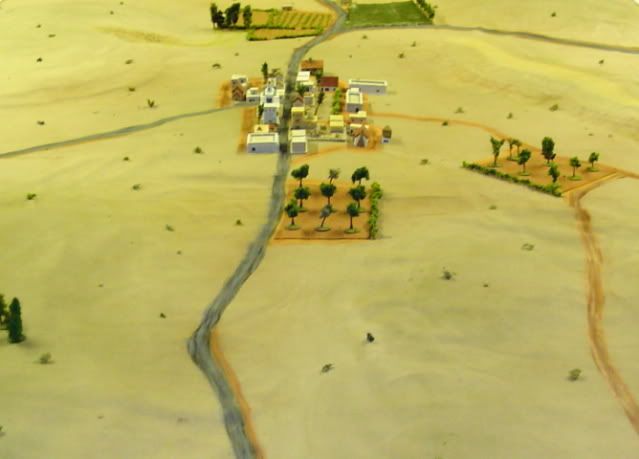
The town lies on the crossing of several major and minor roadways. To the north-east is the road to a dam over the Kebir river, about 8 miles away. The reservoir at Barrage de l’Oued Kebir provides more than half of the water supply for Tunis. To the north / north-west is the road to Sidi Said.To the east lies a dirt track that runs through the Karachoum Gap. (The track also branches south to old Roman ruins that overlook Hir Moussa just 2km away.)The road to the south runs to Ousseltia. The road to the west cuts through to the crossroads village of Rebaa Ouiad Yahia, 5 miles south of Sidi Said.Kampfgruppe Weber opened the offensive by moving on the Barrage from Pont du Fas yesterday. With the reservoir firmly in hand, the Germans have struck out westward towards Bou Arada and Sidi Said. The Italian Superga Division has been tasked to advance along the Germans’ southern flank.Superga has pushed the French outposts off of the Dorsal in the area of the Karachoum Gap. A company of French infantry has set up blocking positions in the village of Hir Moussa to protect the crossroads and delay the Axis advance. The British 36th Brigade is advancing from Gafour towards Sidi Said, and CCB of the US 1st Armored Division is advancing into the Ousseltia Valley from Kesra to the south.The village of Hir Moussa is set in a hollow amidst the many small hills and ridges north of the Ousseltia Valley. Typical of Arab towns, even with wide-open land on all sides, the dusty streets of the village are small and the structures closely packed. South of the village there are some small olive orchards. Cultivated fields lie just to the north. There are ridge lines around the village on four sides. A rocky wet wadi feeds scant moisture to the crop fields from one of the rises. OPENNING MOVESThe French were allowed to set-up in the village, and anywhere they wanted south of the village. The French force consisted of a company of four platoons of infantry. The French were allowed to set up one roadblock in the village. The company commander consolidated the 60mm mortars from the platoons into a single battery under his direct control. An HMG platoon of four 8mm Hotchkiss guns was attached. The French had also managed to lay hands on a single 2pdr AT gun from a British unit, which had surplussed it off as they upgraded to 6pdrs. Also a battery of 75mm guns was available on-board, which set-up in the tree line on a ridge SW of the village.The Italians were split between two commands. A recon force came in on the road from the Barrage de l’Oued Kebir. This force was highly mobile, with high fire power, but fragile. It consisted of a detachment of two Saharien platoons of 2 vehicles each, two armored car platoons of 3 AB-41s each, a battery of two truck-mounted 65mm auto-cannone with an AB-41 battery command car. The detachment commander had a Saharianna car, for a total of six activations. The Saharianna platoons could also dismount one scout rifle squad per two vehicles if desired, leaving the vehicles manned with just their drivers.A separate more powerful combined arms column came down the road from Sidi Said. This force consisted of a company of 11 M13-40 tanks (three platoons of 3, and a two tank company HQ), a company of infantry mounted in trucks, with attached MG platoon from the battalion weapons company and a battery of two Breda M35 47mm ATGs, a battery of 4 Semoventi da 75 M13s with a Carro Commando M13, and a single 75mm gun with prime mover to provide some direct fire support if/as needed (as no artillery resources were available in time to support this highly mobile force).French orders were to hold the village and the crossroads. The French force was built to be “sticky” – hard to root out of the village. Victory conditions were based on holding the village, and surviving.Italian orders were to strike to the west, taking the road towards Rebaa Ouiad Yahia, either flanking the British counter-attack on Sidi Said, or protecting the Germans from a flanking attack by that same force. The two Italian commanders were equals, with no subordination. They were allowed to develop a coordinated plan of attack, but once the game started they were not allowed to discuss plans unless they put HQ units in close contact.Victory conditions for the Italians were based on the number of units they could exit from the board along the west road. They had no victory conditions related to taking the village.
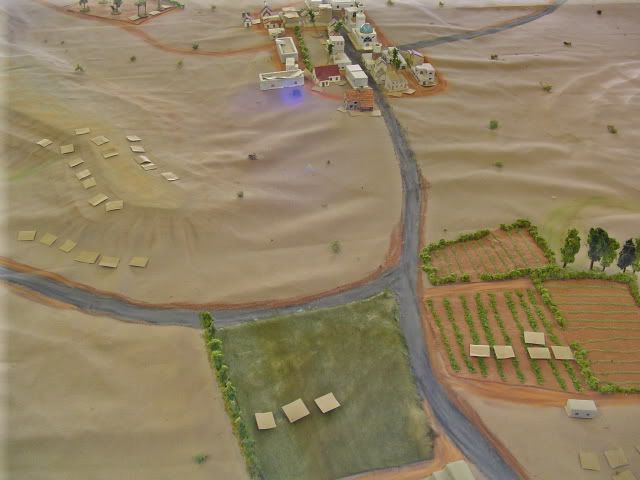
Here in a view from the north we see the Italians moving up. All units are represented by paper chits at this time, with an un-known number of blanks in each side’s hand.The Italian recon detachment can be seen on the left, taking the north-east ridge. The heavier combined arms force moved up to take positions in the agricultural fields north of the village (seen front and center in the picture). The Saharien dismounted their scouts to cross over the ridge and study the village for signs of the enemy. (A few blanks accompanied the two actual scout squads as they crossed the ridgeline.)
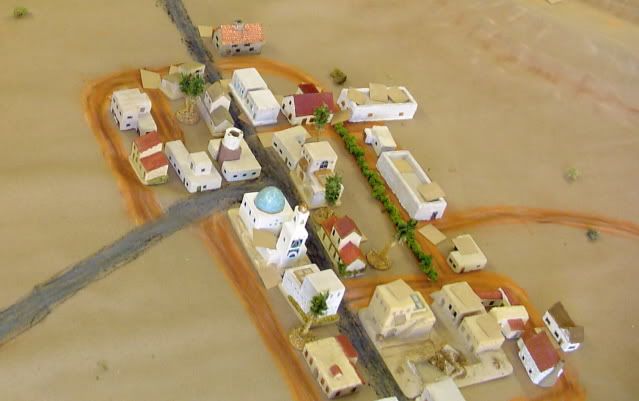
Unfortunately for the Italians, all they could report were their own suspicions – the town looked too quiet, and they expected defenders in each and every corner. Unable to see any actual defenders, the Saharien moved their vehicles forward to pick up their scouts.
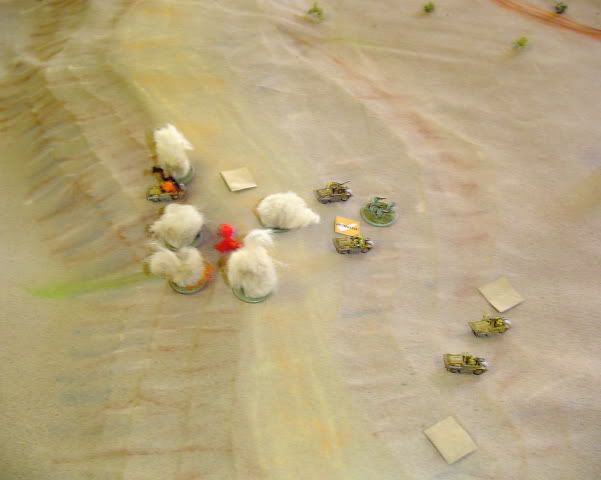
Almost immediately 60mm mortar rounds began falling around them. A Saharianna car was blown up in this first barrage.The recon troops at this point figured that the fight was on, and given a pre-disposition not to sit under mortar fire, decided to charge in to action.

Here we see the Saharien struggling to pick up their scouts under fire, while the AB41s move quickly around the ridge to advance on the village. The auto-cannone move to set-up firing positions in support.
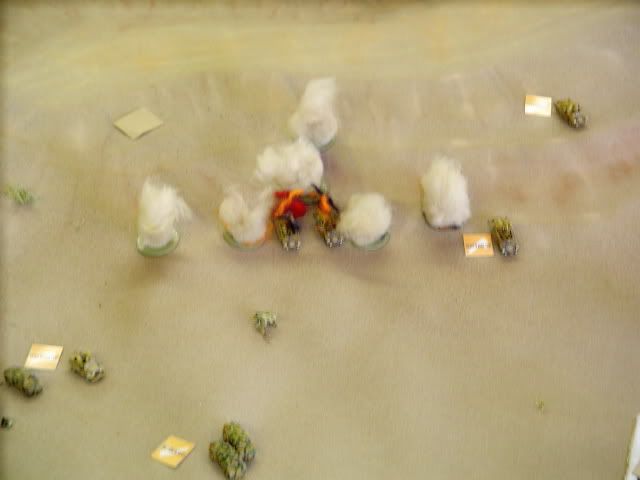
The Saharien are getting hammered, now not only by 60mm mortars but also by 75mm guns. This is more than the light Saharianna vehicles can withstand. Casualties mount quickly.
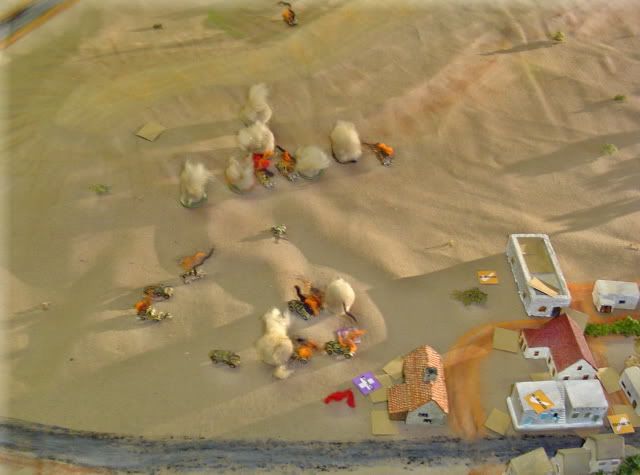
Looking eastward along the north edge of the village, we find the Italians frustrated by their in-ability to spot the defenders in the northern most stone house. Repeated attempts come up empty. In the meantime, the French artillery fire is now split between the Saharien on the ridge (now mostly dead) and the AB41s near town, while HMGs open up on both the AB41s and the un-armored auto-cannone guns. The Italian recon is dying very quickly.
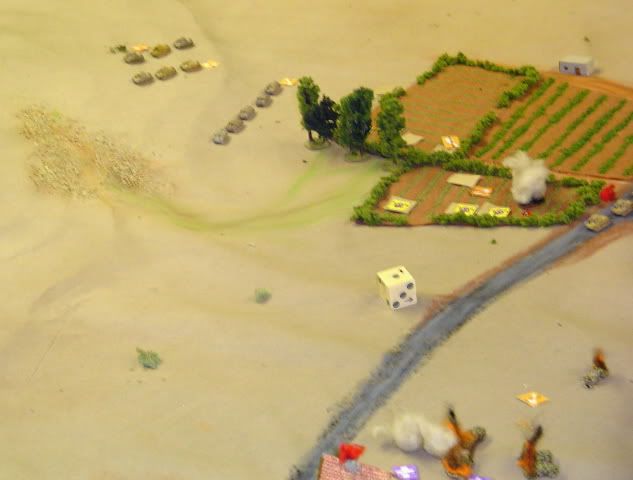
Looking from the edge of the village northward, we see that the second Italian command now launches its forces in support of the recon.French artillery tries to intercede along the road, but drifts onto the cultivated fields. Unknown to the French, this causes casualties among the Italian gun-line (which had not yet been spotted). Two platoons of M13s and the Semoventi battery move out cross-country to flank the town and reach the west road. They separate to go around the rough ground of the rocky wadi.
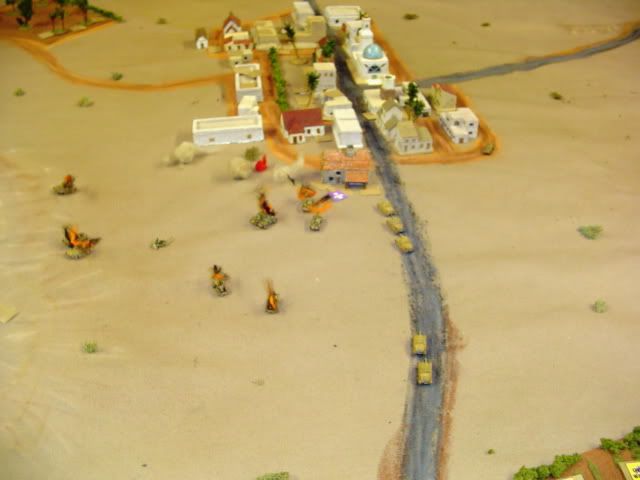
The third platoon of Italian M13 tanks, along with the company HQ, race southward down the road towards the village to aid their bretheren in the recon. Well, not really “race”. With M13s it might be better to describe the advance as a “waddle” than a “race”. By the time they close up on the village, the recon is mostly dead, and still no defenders have been spotted.
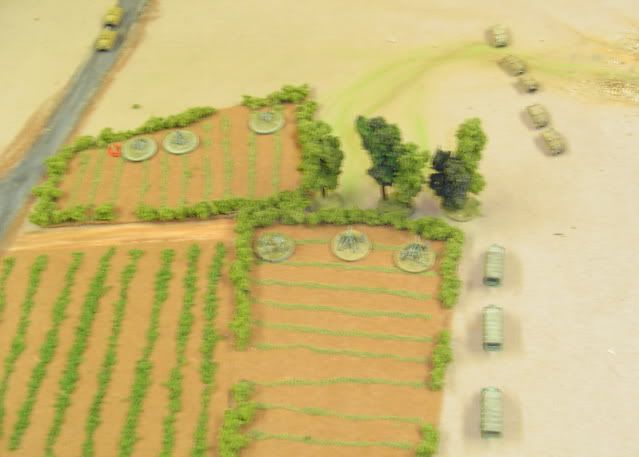
The Italian infantry remain in their trucks, unwilling to move out until they know where to go.In this view from the north you can also see the Italian gun line. On the left end of the hedge you can see a red base with a figure of a body. This was my first time using one as a casualty marker.http://i10.photobucket.com/albums/a122/Mark-1/USTDsArrive.jpgWith more units looking from more directions, the Italians finally spot the enemy. Except it isn’t the French they see. South of the village, new units are flooding on to the board. As the Italians watch in wonder, they determine that these are AMERICAN units.http://i10.photobucket.com/albums/a122/Mark-1/SemoventisadvancepastItalianGunLine.jpgHow fast can the Italians move? Unhappily for them, not very. Their armor crawls forward at a discouraging pace.http://i10.photobucket.com/albums/a122/Mark-1/USM3TDGunLine.jpgWhile, with surprising speed American vehicles deploy from the south road onto the southwest ridge, and set up a line of vehicles overlooking the west road.http://i10.photobucket.com/albums/a122/Mark-1/USM3TDGunline2.jpgThe major portion of a US tank destroyer company has arrived and deployed. These 75mm gun –armed halftracks are quick! And they bring the most firepower of any units on the board. One of the American platoon commanders quickly contacts the French 75mm gun battery on the hill to coordinate their fireplan.http://i10.photobucket.com/albums/a122/Mark-1/USM6TDsinOliveGrove.jpgIn the meantime the “light” platoon of M6 truck-mounted 37mm tank destroyers sets up in the southern olive grove to back-up the French in the village, while the company commander races forward into the village streets to find the French overall CO.http://i10.photobucket.com/albums/a122/Mark-1/HirMoussaVillagefullofFrenchInfantr.jpgThe village of Hir Moussa is still firmly in French hands. US vehicles scamper around the dusty allies looking for the French CO, who sits in the Mosque directing the fire of the mortars in the courtyard.The French have taken no casualties. In fact, they have not even been spotted.http://i10.photobucket.com/albums/a122/Mark-1/Italian75WatchesBattle.jpgA lone Italian 75mm gun placed on a hill 2km to the northwest has watched over the entire affair. Never had a target, never fired a shot. Now, the road to the west is effectively closed. There is no way for Italian armor to run the gauntlet of guns that overlook that road from the ridge. They might be able to fight their way into the village, but to what point? It is not even in their orders to take this miserable piece of dirt. And enough good men have died already.The Italians recall their forces, and prepare to disengage.http://i10.photobucket.com/albums/a122/Mark-1/Re-InforcementsfortheFrench.jpgFrom the south, Nessie, the allies’ true and trusted mascot, a veteran of combat and many warzones, has also watched the whole affair. She trumpets her approval.http://i10.photobucket.com/albums/a122/Mark-1/FrenchEndingPositions.jpgHere is the final disposition in Hir Moussa, when we called the game.I am afraid the Italians did not enjoy this game as much as others I have run. They basically got shot to pieces and could not do much about it. As a game master I made a couple of key mistakes in setting this one up -- most notably in the distribution of forces. The Italians had an overwhelmingly superior force at the outset. But I think it was too complicated for them to use effectively.My wargaming tends to be grown-up manifestation of my childhood years of “playing army”. My imagination gets heavily involved as I develop my scenarios. I fight the game over and over in my own mind, and construct it so that, if I were playing both sides, it would be balanced. In this case I made a game that was very interesting … to me. Of course it is easy for me to spout off about how the forces should have been used. I had lots of time to think about it, and imagine the battle, before hand. But my Italian commanders were handed a box full of models, a unit stats sheet, and a set of orders, and had no real time to work out what was actually in their hands. The Italian recon was a highly mobile force with a lot of firepower. It could easily have skirted the town – either running for the west road (and victory points) or setting up a blocking position to prevent re-enforcements from the south. Instead it was wasted in a frontal assault on an unseen enemy.The Italian combined arms force had an overwhelming combat advantage against the French. Even the Americans, with their high firepower, would have easily fallen to the gunfire of the Italian tanks at close range. But they stood back and waited/watched, until it was too late to engage on advantageous terms.As it was, the Italians spent most of the game fixated on trying to spot units that were in fact blanks. That adds to a game when it is a 2 or 3 turn distraction, but gets to be painful when a player’s entire game is spent at it.Not that the results weren’t interesting, and even reasonable. It is true that commanders sometimes carry their assumptions into battle to their own detriment. The Italians assumed that the French commander, would have a bunch of AT assets edging the town. Their plan was to draw out the fire of the AT assets with the recon force, so that the tanks, semoventis and gun line could silence them with superior firepower. Once the AT assets were suppressed or destroyed, the tanks and infantry could head for the west road, skirting the village un-molested.And the interesting thing is that the French would have let the Italians do it. French orders were to hold the village. Most of the resources were set up in the second line of buildings, to be used in close-quarters fighting in the center of the built-up area, so avoiding the superior firepower of the Italian forces. If the tanks had maneuvered around the village, the French would have let them … what else could they do?But alas, as the Italians started loosing recon assets without drawing out AT gun fire they just became more and more fixated on finding the AT guns and getting them to un-mask, never even trying to spot the HMGs that actually WERE firing until there were no recon assets left. They were boxing with shadows the whole time.-Mark 1
 The town lies on the crossing of several major and minor roadways. To the north-east is the road to a dam over the Kebir river, about 8 miles away. The reservoir at Barrage de l’Oued Kebir provides more than half of the water supply for Tunis. To the north / north-west is the road to Sidi Said.To the east lies a dirt track that runs through the Karachoum Gap. (The track also branches south to old Roman ruins that overlook Hir Moussa just 2km away.)The road to the south runs to Ousseltia. The road to the west cuts through to the crossroads village of Rebaa Ouiad Yahia, 5 miles south of Sidi Said.Kampfgruppe Weber opened the offensive by moving on the Barrage from Pont du Fas yesterday. With the reservoir firmly in hand, the Germans have struck out westward towards Bou Arada and Sidi Said. The Italian Superga Division has been tasked to advance along the Germans’ southern flank.Superga has pushed the French outposts off of the Dorsal in the area of the Karachoum Gap. A company of French infantry has set up blocking positions in the village of Hir Moussa to protect the crossroads and delay the Axis advance. The British 36th Brigade is advancing from Gafour towards Sidi Said, and CCB of the US 1st Armored Division is advancing into the Ousseltia Valley from Kesra to the south.The village of Hir Moussa is set in a hollow amidst the many small hills and ridges north of the Ousseltia Valley. Typical of Arab towns, even with wide-open land on all sides, the dusty streets of the village are small and the structures closely packed. South of the village there are some small olive orchards. Cultivated fields lie just to the north. There are ridge lines around the village on four sides. A rocky wet wadi feeds scant moisture to the crop fields from one of the rises. OPENNING MOVESThe French were allowed to set-up in the village, and anywhere they wanted south of the village. The French force consisted of a company of four platoons of infantry. The French were allowed to set up one roadblock in the village. The company commander consolidated the 60mm mortars from the platoons into a single battery under his direct control. An HMG platoon of four 8mm Hotchkiss guns was attached. The French had also managed to lay hands on a single 2pdr AT gun from a British unit, which had surplussed it off as they upgraded to 6pdrs. Also a battery of 75mm guns was available on-board, which set-up in the tree line on a ridge SW of the village.The Italians were split between two commands. A recon force came in on the road from the Barrage de l’Oued Kebir. This force was highly mobile, with high fire power, but fragile. It consisted of a detachment of two Saharien platoons of 2 vehicles each, two armored car platoons of 3 AB-41s each, a battery of two truck-mounted 65mm auto-cannone with an AB-41 battery command car. The detachment commander had a Saharianna car, for a total of six activations. The Saharianna platoons could also dismount one scout rifle squad per two vehicles if desired, leaving the vehicles manned with just their drivers.A separate more powerful combined arms column came down the road from Sidi Said. This force consisted of a company of 11 M13-40 tanks (three platoons of 3, and a two tank company HQ), a company of infantry mounted in trucks, with attached MG platoon from the battalion weapons company and a battery of two Breda M35 47mm ATGs, a battery of 4 Semoventi da 75 M13s with a Carro Commando M13, and a single 75mm gun with prime mover to provide some direct fire support if/as needed (as no artillery resources were available in time to support this highly mobile force).French orders were to hold the village and the crossroads. The French force was built to be “sticky” – hard to root out of the village. Victory conditions were based on holding the village, and surviving.Italian orders were to strike to the west, taking the road towards Rebaa Ouiad Yahia, either flanking the British counter-attack on Sidi Said, or protecting the Germans from a flanking attack by that same force. The two Italian commanders were equals, with no subordination. They were allowed to develop a coordinated plan of attack, but once the game started they were not allowed to discuss plans unless they put HQ units in close contact.Victory conditions for the Italians were based on the number of units they could exit from the board along the west road. They had no victory conditions related to taking the village.
The town lies on the crossing of several major and minor roadways. To the north-east is the road to a dam over the Kebir river, about 8 miles away. The reservoir at Barrage de l’Oued Kebir provides more than half of the water supply for Tunis. To the north / north-west is the road to Sidi Said.To the east lies a dirt track that runs through the Karachoum Gap. (The track also branches south to old Roman ruins that overlook Hir Moussa just 2km away.)The road to the south runs to Ousseltia. The road to the west cuts through to the crossroads village of Rebaa Ouiad Yahia, 5 miles south of Sidi Said.Kampfgruppe Weber opened the offensive by moving on the Barrage from Pont du Fas yesterday. With the reservoir firmly in hand, the Germans have struck out westward towards Bou Arada and Sidi Said. The Italian Superga Division has been tasked to advance along the Germans’ southern flank.Superga has pushed the French outposts off of the Dorsal in the area of the Karachoum Gap. A company of French infantry has set up blocking positions in the village of Hir Moussa to protect the crossroads and delay the Axis advance. The British 36th Brigade is advancing from Gafour towards Sidi Said, and CCB of the US 1st Armored Division is advancing into the Ousseltia Valley from Kesra to the south.The village of Hir Moussa is set in a hollow amidst the many small hills and ridges north of the Ousseltia Valley. Typical of Arab towns, even with wide-open land on all sides, the dusty streets of the village are small and the structures closely packed. South of the village there are some small olive orchards. Cultivated fields lie just to the north. There are ridge lines around the village on four sides. A rocky wet wadi feeds scant moisture to the crop fields from one of the rises. OPENNING MOVESThe French were allowed to set-up in the village, and anywhere they wanted south of the village. The French force consisted of a company of four platoons of infantry. The French were allowed to set up one roadblock in the village. The company commander consolidated the 60mm mortars from the platoons into a single battery under his direct control. An HMG platoon of four 8mm Hotchkiss guns was attached. The French had also managed to lay hands on a single 2pdr AT gun from a British unit, which had surplussed it off as they upgraded to 6pdrs. Also a battery of 75mm guns was available on-board, which set-up in the tree line on a ridge SW of the village.The Italians were split between two commands. A recon force came in on the road from the Barrage de l’Oued Kebir. This force was highly mobile, with high fire power, but fragile. It consisted of a detachment of two Saharien platoons of 2 vehicles each, two armored car platoons of 3 AB-41s each, a battery of two truck-mounted 65mm auto-cannone with an AB-41 battery command car. The detachment commander had a Saharianna car, for a total of six activations. The Saharianna platoons could also dismount one scout rifle squad per two vehicles if desired, leaving the vehicles manned with just their drivers.A separate more powerful combined arms column came down the road from Sidi Said. This force consisted of a company of 11 M13-40 tanks (three platoons of 3, and a two tank company HQ), a company of infantry mounted in trucks, with attached MG platoon from the battalion weapons company and a battery of two Breda M35 47mm ATGs, a battery of 4 Semoventi da 75 M13s with a Carro Commando M13, and a single 75mm gun with prime mover to provide some direct fire support if/as needed (as no artillery resources were available in time to support this highly mobile force).French orders were to hold the village and the crossroads. The French force was built to be “sticky” – hard to root out of the village. Victory conditions were based on holding the village, and surviving.Italian orders were to strike to the west, taking the road towards Rebaa Ouiad Yahia, either flanking the British counter-attack on Sidi Said, or protecting the Germans from a flanking attack by that same force. The two Italian commanders were equals, with no subordination. They were allowed to develop a coordinated plan of attack, but once the game started they were not allowed to discuss plans unless they put HQ units in close contact.Victory conditions for the Italians were based on the number of units they could exit from the board along the west road. They had no victory conditions related to taking the village. Here in a view from the north we see the Italians moving up. All units are represented by paper chits at this time, with an un-known number of blanks in each side’s hand.The Italian recon detachment can be seen on the left, taking the north-east ridge. The heavier combined arms force moved up to take positions in the agricultural fields north of the village (seen front and center in the picture). The Saharien dismounted their scouts to cross over the ridge and study the village for signs of the enemy. (A few blanks accompanied the two actual scout squads as they crossed the ridgeline.)
Here in a view from the north we see the Italians moving up. All units are represented by paper chits at this time, with an un-known number of blanks in each side’s hand.The Italian recon detachment can be seen on the left, taking the north-east ridge. The heavier combined arms force moved up to take positions in the agricultural fields north of the village (seen front and center in the picture). The Saharien dismounted their scouts to cross over the ridge and study the village for signs of the enemy. (A few blanks accompanied the two actual scout squads as they crossed the ridgeline.)  Unfortunately for the Italians, all they could report were their own suspicions – the town looked too quiet, and they expected defenders in each and every corner. Unable to see any actual defenders, the Saharien moved their vehicles forward to pick up their scouts.
Unfortunately for the Italians, all they could report were their own suspicions – the town looked too quiet, and they expected defenders in each and every corner. Unable to see any actual defenders, the Saharien moved their vehicles forward to pick up their scouts. Almost immediately 60mm mortar rounds began falling around them. A Saharianna car was blown up in this first barrage.The recon troops at this point figured that the fight was on, and given a pre-disposition not to sit under mortar fire, decided to charge in to action.
Almost immediately 60mm mortar rounds began falling around them. A Saharianna car was blown up in this first barrage.The recon troops at this point figured that the fight was on, and given a pre-disposition not to sit under mortar fire, decided to charge in to action. Here we see the Saharien struggling to pick up their scouts under fire, while the AB41s move quickly around the ridge to advance on the village. The auto-cannone move to set-up firing positions in support.
Here we see the Saharien struggling to pick up their scouts under fire, while the AB41s move quickly around the ridge to advance on the village. The auto-cannone move to set-up firing positions in support. The Saharien are getting hammered, now not only by 60mm mortars but also by 75mm guns. This is more than the light Saharianna vehicles can withstand. Casualties mount quickly.
The Saharien are getting hammered, now not only by 60mm mortars but also by 75mm guns. This is more than the light Saharianna vehicles can withstand. Casualties mount quickly. Looking eastward along the north edge of the village, we find the Italians frustrated by their in-ability to spot the defenders in the northern most stone house. Repeated attempts come up empty. In the meantime, the French artillery fire is now split between the Saharien on the ridge (now mostly dead) and the AB41s near town, while HMGs open up on both the AB41s and the un-armored auto-cannone guns. The Italian recon is dying very quickly.
Looking eastward along the north edge of the village, we find the Italians frustrated by their in-ability to spot the defenders in the northern most stone house. Repeated attempts come up empty. In the meantime, the French artillery fire is now split between the Saharien on the ridge (now mostly dead) and the AB41s near town, while HMGs open up on both the AB41s and the un-armored auto-cannone guns. The Italian recon is dying very quickly. Looking from the edge of the village northward, we see that the second Italian command now launches its forces in support of the recon.French artillery tries to intercede along the road, but drifts onto the cultivated fields. Unknown to the French, this causes casualties among the Italian gun-line (which had not yet been spotted). Two platoons of M13s and the Semoventi battery move out cross-country to flank the town and reach the west road. They separate to go around the rough ground of the rocky wadi.
Looking from the edge of the village northward, we see that the second Italian command now launches its forces in support of the recon.French artillery tries to intercede along the road, but drifts onto the cultivated fields. Unknown to the French, this causes casualties among the Italian gun-line (which had not yet been spotted). Two platoons of M13s and the Semoventi battery move out cross-country to flank the town and reach the west road. They separate to go around the rough ground of the rocky wadi. The third platoon of Italian M13 tanks, along with the company HQ, race southward down the road towards the village to aid their bretheren in the recon. Well, not really “race”. With M13s it might be better to describe the advance as a “waddle” than a “race”. By the time they close up on the village, the recon is mostly dead, and still no defenders have been spotted.
The third platoon of Italian M13 tanks, along with the company HQ, race southward down the road towards the village to aid their bretheren in the recon. Well, not really “race”. With M13s it might be better to describe the advance as a “waddle” than a “race”. By the time they close up on the village, the recon is mostly dead, and still no defenders have been spotted. The Italian infantry remain in their trucks, unwilling to move out until they know where to go.In this view from the north you can also see the Italian gun line. On the left end of the hedge you can see a red base with a figure of a body. This was my first time using one as a casualty marker.http://i10.photobucket.com/albums/a122/Mark-1/USTDsArrive.jpgWith more units looking from more directions, the Italians finally spot the enemy. Except it isn’t the French they see. South of the village, new units are flooding on to the board. As the Italians watch in wonder, they determine that these are AMERICAN units.http://i10.photobucket.com/albums/a122/Mark-1/SemoventisadvancepastItalianGunLine.jpgHow fast can the Italians move? Unhappily for them, not very. Their armor crawls forward at a discouraging pace.http://i10.photobucket.com/albums/a122/Mark-1/USM3TDGunLine.jpgWhile, with surprising speed American vehicles deploy from the south road onto the southwest ridge, and set up a line of vehicles overlooking the west road.http://i10.photobucket.com/albums/a122/Mark-1/USM3TDGunline2.jpgThe major portion of a US tank destroyer company has arrived and deployed. These 75mm gun –armed halftracks are quick! And they bring the most firepower of any units on the board. One of the American platoon commanders quickly contacts the French 75mm gun battery on the hill to coordinate their fireplan.http://i10.photobucket.com/albums/a122/Mark-1/USM6TDsinOliveGrove.jpgIn the meantime the “light” platoon of M6 truck-mounted 37mm tank destroyers sets up in the southern olive grove to back-up the French in the village, while the company commander races forward into the village streets to find the French overall CO.http://i10.photobucket.com/albums/a122/Mark-1/HirMoussaVillagefullofFrenchInfantr.jpgThe village of Hir Moussa is still firmly in French hands. US vehicles scamper around the dusty allies looking for the French CO, who sits in the Mosque directing the fire of the mortars in the courtyard.The French have taken no casualties. In fact, they have not even been spotted.http://i10.photobucket.com/albums/a122/Mark-1/Italian75WatchesBattle.jpgA lone Italian 75mm gun placed on a hill 2km to the northwest has watched over the entire affair. Never had a target, never fired a shot. Now, the road to the west is effectively closed. There is no way for Italian armor to run the gauntlet of guns that overlook that road from the ridge. They might be able to fight their way into the village, but to what point? It is not even in their orders to take this miserable piece of dirt. And enough good men have died already.The Italians recall their forces, and prepare to disengage.http://i10.photobucket.com/albums/a122/Mark-1/Re-InforcementsfortheFrench.jpgFrom the south, Nessie, the allies’ true and trusted mascot, a veteran of combat and many warzones, has also watched the whole affair. She trumpets her approval.http://i10.photobucket.com/albums/a122/Mark-1/FrenchEndingPositions.jpgHere is the final disposition in Hir Moussa, when we called the game.I am afraid the Italians did not enjoy this game as much as others I have run. They basically got shot to pieces and could not do much about it. As a game master I made a couple of key mistakes in setting this one up -- most notably in the distribution of forces. The Italians had an overwhelmingly superior force at the outset. But I think it was too complicated for them to use effectively.My wargaming tends to be grown-up manifestation of my childhood years of “playing army”. My imagination gets heavily involved as I develop my scenarios. I fight the game over and over in my own mind, and construct it so that, if I were playing both sides, it would be balanced. In this case I made a game that was very interesting … to me. Of course it is easy for me to spout off about how the forces should have been used. I had lots of time to think about it, and imagine the battle, before hand. But my Italian commanders were handed a box full of models, a unit stats sheet, and a set of orders, and had no real time to work out what was actually in their hands. The Italian recon was a highly mobile force with a lot of firepower. It could easily have skirted the town – either running for the west road (and victory points) or setting up a blocking position to prevent re-enforcements from the south. Instead it was wasted in a frontal assault on an unseen enemy.The Italian combined arms force had an overwhelming combat advantage against the French. Even the Americans, with their high firepower, would have easily fallen to the gunfire of the Italian tanks at close range. But they stood back and waited/watched, until it was too late to engage on advantageous terms.As it was, the Italians spent most of the game fixated on trying to spot units that were in fact blanks. That adds to a game when it is a 2 or 3 turn distraction, but gets to be painful when a player’s entire game is spent at it.Not that the results weren’t interesting, and even reasonable. It is true that commanders sometimes carry their assumptions into battle to their own detriment. The Italians assumed that the French commander, would have a bunch of AT assets edging the town. Their plan was to draw out the fire of the AT assets with the recon force, so that the tanks, semoventis and gun line could silence them with superior firepower. Once the AT assets were suppressed or destroyed, the tanks and infantry could head for the west road, skirting the village un-molested.And the interesting thing is that the French would have let the Italians do it. French orders were to hold the village. Most of the resources were set up in the second line of buildings, to be used in close-quarters fighting in the center of the built-up area, so avoiding the superior firepower of the Italian forces. If the tanks had maneuvered around the village, the French would have let them … what else could they do?But alas, as the Italians started loosing recon assets without drawing out AT gun fire they just became more and more fixated on finding the AT guns and getting them to un-mask, never even trying to spot the HMGs that actually WERE firing until there were no recon assets left. They were boxing with shadows the whole time.-Mark 1
The Italian infantry remain in their trucks, unwilling to move out until they know where to go.In this view from the north you can also see the Italian gun line. On the left end of the hedge you can see a red base with a figure of a body. This was my first time using one as a casualty marker.http://i10.photobucket.com/albums/a122/Mark-1/USTDsArrive.jpgWith more units looking from more directions, the Italians finally spot the enemy. Except it isn’t the French they see. South of the village, new units are flooding on to the board. As the Italians watch in wonder, they determine that these are AMERICAN units.http://i10.photobucket.com/albums/a122/Mark-1/SemoventisadvancepastItalianGunLine.jpgHow fast can the Italians move? Unhappily for them, not very. Their armor crawls forward at a discouraging pace.http://i10.photobucket.com/albums/a122/Mark-1/USM3TDGunLine.jpgWhile, with surprising speed American vehicles deploy from the south road onto the southwest ridge, and set up a line of vehicles overlooking the west road.http://i10.photobucket.com/albums/a122/Mark-1/USM3TDGunline2.jpgThe major portion of a US tank destroyer company has arrived and deployed. These 75mm gun –armed halftracks are quick! And they bring the most firepower of any units on the board. One of the American platoon commanders quickly contacts the French 75mm gun battery on the hill to coordinate their fireplan.http://i10.photobucket.com/albums/a122/Mark-1/USM6TDsinOliveGrove.jpgIn the meantime the “light” platoon of M6 truck-mounted 37mm tank destroyers sets up in the southern olive grove to back-up the French in the village, while the company commander races forward into the village streets to find the French overall CO.http://i10.photobucket.com/albums/a122/Mark-1/HirMoussaVillagefullofFrenchInfantr.jpgThe village of Hir Moussa is still firmly in French hands. US vehicles scamper around the dusty allies looking for the French CO, who sits in the Mosque directing the fire of the mortars in the courtyard.The French have taken no casualties. In fact, they have not even been spotted.http://i10.photobucket.com/albums/a122/Mark-1/Italian75WatchesBattle.jpgA lone Italian 75mm gun placed on a hill 2km to the northwest has watched over the entire affair. Never had a target, never fired a shot. Now, the road to the west is effectively closed. There is no way for Italian armor to run the gauntlet of guns that overlook that road from the ridge. They might be able to fight their way into the village, but to what point? It is not even in their orders to take this miserable piece of dirt. And enough good men have died already.The Italians recall their forces, and prepare to disengage.http://i10.photobucket.com/albums/a122/Mark-1/Re-InforcementsfortheFrench.jpgFrom the south, Nessie, the allies’ true and trusted mascot, a veteran of combat and many warzones, has also watched the whole affair. She trumpets her approval.http://i10.photobucket.com/albums/a122/Mark-1/FrenchEndingPositions.jpgHere is the final disposition in Hir Moussa, when we called the game.I am afraid the Italians did not enjoy this game as much as others I have run. They basically got shot to pieces and could not do much about it. As a game master I made a couple of key mistakes in setting this one up -- most notably in the distribution of forces. The Italians had an overwhelmingly superior force at the outset. But I think it was too complicated for them to use effectively.My wargaming tends to be grown-up manifestation of my childhood years of “playing army”. My imagination gets heavily involved as I develop my scenarios. I fight the game over and over in my own mind, and construct it so that, if I were playing both sides, it would be balanced. In this case I made a game that was very interesting … to me. Of course it is easy for me to spout off about how the forces should have been used. I had lots of time to think about it, and imagine the battle, before hand. But my Italian commanders were handed a box full of models, a unit stats sheet, and a set of orders, and had no real time to work out what was actually in their hands. The Italian recon was a highly mobile force with a lot of firepower. It could easily have skirted the town – either running for the west road (and victory points) or setting up a blocking position to prevent re-enforcements from the south. Instead it was wasted in a frontal assault on an unseen enemy.The Italian combined arms force had an overwhelming combat advantage against the French. Even the Americans, with their high firepower, would have easily fallen to the gunfire of the Italian tanks at close range. But they stood back and waited/watched, until it was too late to engage on advantageous terms.As it was, the Italians spent most of the game fixated on trying to spot units that were in fact blanks. That adds to a game when it is a 2 or 3 turn distraction, but gets to be painful when a player’s entire game is spent at it.Not that the results weren’t interesting, and even reasonable. It is true that commanders sometimes carry their assumptions into battle to their own detriment. The Italians assumed that the French commander, would have a bunch of AT assets edging the town. Their plan was to draw out the fire of the AT assets with the recon force, so that the tanks, semoventis and gun line could silence them with superior firepower. Once the AT assets were suppressed or destroyed, the tanks and infantry could head for the west road, skirting the village un-molested.And the interesting thing is that the French would have let the Italians do it. French orders were to hold the village. Most of the resources were set up in the second line of buildings, to be used in close-quarters fighting in the center of the built-up area, so avoiding the superior firepower of the Italian forces. If the tanks had maneuvered around the village, the French would have let them … what else could they do?But alas, as the Italians started loosing recon assets without drawing out AT gun fire they just became more and more fixated on finding the AT guns and getting them to un-mask, never even trying to spot the HMGs that actually WERE firing until there were no recon assets left. They were boxing with shadows the whole time.-Mark 1









